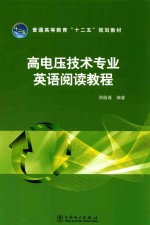图书介绍
高电压技术专业英语阅读教程PDF|Epub|txt|kindle电子书版本网盘下载

- 郑殿春编著;张沛红主审 著
- 出版社: 北京:中国电力出版社
- ISBN:9787512372658
- 出版时间:2015
- 标注页数:181页
- 文件大小:32MB
- 文件页数:190页
- 主题词:高电压-技术-英语-阅读教学-高等学校-教材
PDF下载
下载说明
高电压技术专业英语阅读教程PDF格式电子书版下载
下载的文件为RAR压缩包。需要使用解压软件进行解压得到PDF格式图书。建议使用BT下载工具Free Download Manager进行下载,简称FDM(免费,没有广告,支持多平台)。本站资源全部打包为BT种子。所以需要使用专业的BT下载软件进行下载。如BitComet qBittorrent uTorrent等BT下载工具。迅雷目前由于本站不是热门资源。不推荐使用!后期资源热门了。安装了迅雷也可以迅雷进行下载!
(文件页数 要大于 标注页数,上中下等多册电子书除外)
注意:本站所有压缩包均有解压码: 点击下载压缩包解压工具
图书目录
Unit 1 Gas Discharge Phenomena1
1.1 Classification of Discharges1
1.2 Current-voltage Characteristics of DC Discharge2
1.2.1 Non-self-sustaining Discharge3
1.2.2 Townsend Discharge3
1.2.3 Glow Discharge4
1.2.4 Transition to Arc Discharge5
1.3 Townsend Breakdown5
1.4 Production and Loss of Charges in a Gas8
Unit 2 Non-Destructive High-voltage Tests12
2.1 Loss in a Dielectric12
2.2 Measurement of the Conduction Current for Direct Voltage13
2.3 Measurement of the Dissipation Factor for Alternating Voltage14
2.3.1 Dielectric Loss and Equivalent Circuits14
2.3.2 Measurement with the Schering Bridge16
2.4 Measurement of Partial Discharges at Alternating Voltages17
2.4.1 External Partial Discharges18
2.4.2 Internal Partial Discharges20
Unit 3 Liquid and Composite Dielectrics23
3.1 Liquid Characteristics23
3.2 Solid Dielectrics23
3.3 Composites24
3.4 Estimation and Control of Electrical24
3.5 Electric Fields26
3.6 Uniform and Non-Uniform Electric Fields26
3.7 Estimation of Electric Field in Some Geometric Boundaries27
3.7.1 Parallel Plates27
3.7.2 Concentric Cylinders28
3.7.3 Parallel Cylinders of Equal Diameter28
3.8 Surge Voltages,Their Distribution And Control28
Unit 4 Breakdown in Air Gaps with Solid Insulating Barrier under Impulse Voltage Stress31
4.1 Introduction31
4.2 The First Approach for the Understanding of the Barrier Effect32
4.3 Barriers with Opening35
4.4 In Depth Investigation of the Breakdown Process37
4.5 Quantitative Analysis of Spaces Charges39
4.6 Flashover Around the Barrier without Penetration41
4.7 Barrier Effect in Symmetric Fields42
4.8 Investigations with Other Types of Voltages43
4.9 Conclusions44
Unit 5 Specialized Knowledge of Cables46
5.1 Material Technology46
5.2 Conductor and Insulation Screens47
5.3 Cable Design49
5.4 Manufacturing50
5.5 Installation Design51
5.6 Joints/Terminations54
5.7 Minute Step Voltage Test56
Unit 6 Treeing Phenomena of XLPE Cable58
6.1 Introduction58
6.2 Failures of XLPE Cable58
6.3 Treeing Phenomena in XLPE Cables60
6.4 Electrical Trees and Mechanisms60
6.5 Water Trees and Mechanisms62
Unit 7 Specialized Knowledge of Power Transformers65
7.1 Features65
7.2 Core66
7.3 Winding68
7.3.1 Hisercap Disk Winding(Interleaved Disk Winding)68
7.3.2 Continuous Disk Winding68
7.3.3 Helical Coil69
7.4 Insulation Structure70
7.5 Prevention of Internal Partial Discharge and Insulation71
7.5.1 Treatment71
7.5.2 Drying/Oil Filling Treatment72
7.5.3 Removing Voids72
7.5.4 Electric Field Control72
7.5.5 Dust Control73
7.6 Measures against Leakage Flux73
7.7 Tank74
7.8 Cooling System75
7.8.1 Self-cooled Type75
7.8.2 Air-cooled-air-cooled76
7.8.3 Forced-oil,Forced-air-cooled Type76
7.8.4 Forced-oil,Water-cooled Type77
7.9 Accessories78
7.9.1 Oil Preservation System78
7.9.2 Diaphragm-type Oil Preservation System(Type OH-D)78
7.9.3 Dehydrating Breather(Types FG,FP,FS)79
7.9.4 Dial Oil Level Indicator79
7.9.5 Protective Relays80
7.9.6 Buchholtz Relay80
7.9.7 Liquid Temperature Indicator81
7.9.8 Winding Temperature Indicator Relay81
7.9.9 Pressure Relief Device82
7.10 Low-noise Transformer84
7.11 Construction of Cable Connection and GIS86
7.11.1 Connection Cable Connection86
7.11.2 GIS(Gas Insulated Switchgear) Connection86
7.11.3 Transportation87
Unit 8 Investigation of Sub-Nanosecond Breakdown through Computational Methods90
8.1 Introduction90
8.2 Background Theory and Prior Research91
8.2.1 Background Discharge Regimes in Pulsed Breakdown91
8.2.2 Townsend Regime91
8.2.3 Streamer Regime92
8.2.4 Post Streamer Regime93
8.3 Physical Processes in Picosecond Breakdown94
8.3.1 Field Emission94
8.3.2 Electron-Neutral Collisions96
8.3.3 Runaway Electrons97
8.3.4 Explosive Electron Emission99
8.4 Recent Research Efforts100
Unit 9 Numerical Simulation of Gas Discharge106
9.1 Governing Equations106
9.1.1 Two-Fluid Theory107
9.1.2 Coefficients110
9.1.3 Boundary Conditions111
9.2 Model Equations in Dimensionless Form112
9.2.1 Numerical Approach and Results113
9.2.2 Grid and Discretization113
9.2.3 θ-Method115
9.2.4 Time Step and Iteration116
9.2.5 Boundary Conditions and Error117
9.3 One Dimensional Model117
9.3.1 Thomas Algorithm and Results120
9.3.2 Two Dimensional Model123
9.3.3 Successive Over Relaxation Method126
9.3.4 Results127
9.3.5 Convergence127
9.4 Dynamic Characteristics of SF6-N2-CO2 Gas Mixtures in DC Discharge Process128
9.4.1 The Hybrid Computing Model129
9.4.2 Development of the Avalanche and Streamer132
9.4.3 Spatial Electric Field and Electron Velocity134
9.4.4 Influence of Photoionization135
Unit 10 Pattern Dynamics in a Two-dimensional Gas Discharge System139
10.1 Introduction139
10.2 Experiment140
10.3 Model141
10.3.1 Assumption141
10.3.2 Specific Model142
10.3.3 Constraint for the Constant Total Charge144
10.3.4 Flowing Charge Density145
10.3.5 Parameter Setting145
10.4 Phenomena146
10.4.1 Preparation:Behavior of Each Element Under the Global Constraint146
10.4.2 Global Phase Diagram147
10.4.3 DS Phase148
10.4.4 LS Phase149
10.4.5 Moving Spot Phase155
10.5 Summary and Discussion159
10.5.1 Summary159
10.5.2 Comparison with the Experiment by Nasuno160
10.5.3 Discussion160
附录1 高电压技术常用词汇中英文对照162
附录2 绝缘介质电特性中英文对照169
附录3 美国工程索引(EI)对文摘的要求176
参考文献180